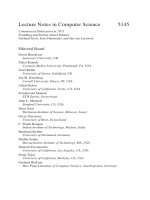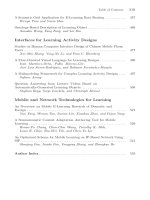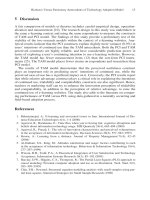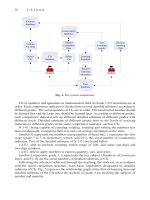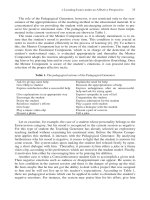Lecture Notes in Computer Science- P45 pps
Bạn đang xem bản rút gọn của tài liệu. Xem và tải ngay bản đầy đủ của tài liệu tại đây (331.61 KB, 5 trang )
Development of Contents Improving the Effectiveness of Self Learning 209
contents using the web were developed, and these are based on the main teaching
materials and the secondary materials. The web-based contents should generally be
interactive, and these should offer various media and in particular be made for piqu-
ing the student's interest. The guideline for development of contents consists of an
interactive contents model, a process contents model, a practical contents model, an
animation contents model, a multimedia contents model etc., as shown in figure 1.
These models are not mutually exclusive [ figure 2-5 ].
Fig. 1. Web-based education; cyber contents model
1.1 Interactive Contents Model
Based on the development of virtual education at Arizona state university, they
achieved good results because of the fact that users are capable of seeing interactive
control methods about signal processing, using distance education to use a graphics
processing function in JAVA, as shown in figure 2.
Fig. 2. Interactive contents model
210 S. Han et al.
1.2 Practical Contents Model
This model can enable the user to experience the processing of algorithms as a visual
display, and aid in understanding the principles of algorithms. At SUNCHUNHY-
ANG university, research team member[ Kwan Sun Choi, Hong Gu Jheon], devel-
oped a web-based C compiler system, capable of using a server side compiler which
doesn’t require installation. The computer working on the internet using the web cre-
ates C program source code, and compiles and obtains the external results[5].
Fig. 3. Practical contents model
1.3 Process Contents Model
For this model the learning contents are presented in stages. To acquire the princi-
ples, the learning contents are arranged successively, such as an application program,
a device using method etc. Figure 4 compares a human and a computer with respect to
storage capacity, connection complexity and data transfer speed. This shows the proc-
ess that occurs, and the user presses a button for the next stage.
Fig. 4. Compares a human and a computer with respect to storage capacity
Development of Contents Improving the Effectiveness of Self Learning 211
1.4 Animation Contents Model
An abstract principle or a concept represented as a simple image and a text through an
animation based on a scenario, can enable a user to understand more and master difficult
concepts. figure 5 is the animation of a checker game, implemented with a JAVA applet.
Fig. 5. A Multimedia contents model
This model is presented to a user using an image, a graphic, and visual symbols in
general. Figure 6 was a simulated experiment that has been implemented by Dong Sik
Kim, Sun Hyum Lee, Kwan Sun Choi in SUNCHEONHYANG university research
team. This was implemented as a measuring device and a circuit device, virtually,
with software on the web, just as an experiment in an actual state. Then, students
practiced an interesting preliminary experiment, using a mouse for an easy operation.
Wiring methods are represented by visual symbols.[8].
This study aims to develop virtual education contents using the web. Thus, we pro-
duced a flash quiz , to measure the ability to use a function, concept understanding
Fig. 6. Multimedia contents model
212 S. Han et al.
and the level of understanding of statements. While we were developing the educa-
tional learning contents, since it is important to study a programming language for
aiding in understanding of algorithms,, we made sort algorithms and hanoi top trans-
fer algorithms in JAVA. In this article, we provide an explanation of the making of
flashes of a C language standard function, quizzes made with flash, flash animations
to understand concepts, and making an applet to understand an algorithm.
2 Implementation of Contents Using JAVA, FLASH
In this article, we produced various contents to use flash and JAVA to help students
who attend a computer programming lecture to understand the concepts. We imple-
mented all functions which are used in the C language, and how to use these, with
flash animation. If students search for a function's name with a search function, stu-
dents will be able to perform functions that are implemented with flash animation.
2.1 The Flash Production of a C Language Standard Function
Firstly, if a student inputs a log10 function, to be given for making an calculation with
some real number value of common logarithms, and presses a search button, the results
will be shown in a flash window, such as figure 8. If a student presses the play-button,
the student can see how the X input value is transformed into log10(x) and assigned to
Y as the output value. To stop, he or she presses a stop-button, and is able to
Fig. 7. Function Search window
Fig. 8. Log10 function made with flash
Development of Contents Improving the Effectiveness of Self Learning 213
halt the operations. If the student presses the speaker-button, he or she can listen to an
explanation about a function, from the computer. If the student presses the button using
the example, he or her can see the outcomes, such as the function of this example.
Secondly, The fseek function produced by flash that makes a stack pointer(fp)
which is transferred any place, is shown in figure 9. Thirdly, as an animation of the
fputc function, this function can write characters one by one, as shown in figure 10,
We can see how to write "hello" in a character type variable str, through a writing
process which opened a file in writing mode.
Fig. 9. Fseek function made with flash
Fig. 10. Fputs function made with flash
Example of an 'if-else statement' quiz implemented to measure the user's under-
standing with flash. The student inputs any numbers in the text-box indicated by the
finger. Based on the 'if statement', when the statement is true, a red box is drawn on the
screen. When the statement is false, a yellow box is drawn on the screen, as shown in
